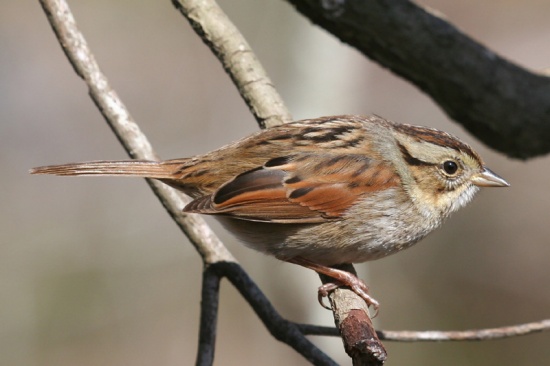- Melospiza georgiana
Identification
5 ins (12-14cm)
- Streaked rusty and black upperparts
- Gray breast
- Light belly
- White throat
- Solid rust-colored cap (with pale central stripe in winter)
- Rusty wings
- Gray face
- Dark line through the eye
- Short bill
- Fairly long legs
Distribution
Central Canada, North and Central America
Canada: Alberta, British Columbia, Manitoba, New Brunswick, Newfoundland, Labrador, Nova Scotia, Northwest Territories, Ontario, Prince Edward Island, Saskatchewan and Yukon
United States of America: New England, Alabama, Arkansas, Arizona, California, Colorado, Connecticut, District of Columbia, Delaware, Florida, Georgia, Iowa, Idaho, Illinois, Indiana, Kansas, Kentucky, Louisiana, Massachusetts, Maryland, Maine, Michigan, Minnesota, Missouri, Mississippi, North Carolina, North Dakota, Nebraska, New Hampshire, New Jersey, New Mexico, Nevada, New York, Ohio, Oklahoma, Oregon, Pennsylvania, South Carolina, South Dakota, Tennessee, Texas, Virginia, Vermont, Washington, Wisconsin, West Virginia and Wyoming
Central America: Mexico and Baja California
Taxonomy
Subspecies[1]
There are 3 subspecies:
- M. g. ericrypta:
- M. g. georgiana:
- North Dakota to Nova Scotia and north-eastern US; winters to southern Texas and Florida
- M. g. nigrescens:
- Atlantic coast from New Jersey to Maryland
Habitat
Swamps, marshes, damp fields, bogs, floodplains, salt marshes.
Behaviour
Breeding
It builds a bulky nest with leaves arching over the top, which is attached to marsh vegetation.
Diet
The diet includes insects and seeds.
References
- Clements, JF. 2009. The Clements Checklist of Birds of the World. 6th ed., with updates to December 2009. Ithaca: Cornell Univ. Press. ISBN 978-0801445019.
- Avibase
- Wikipedia
- BF Member observations
Recommended Citation
- BirdForum Opus contributors. (2025) Swamp Sparrow. In: BirdForum, the forum for wild birds and birding. Retrieved 16 May 2025 from https://www.birdforum.net/opus/Swamp_Sparrow
External Links
GSearch checked for 2020 platform.1





